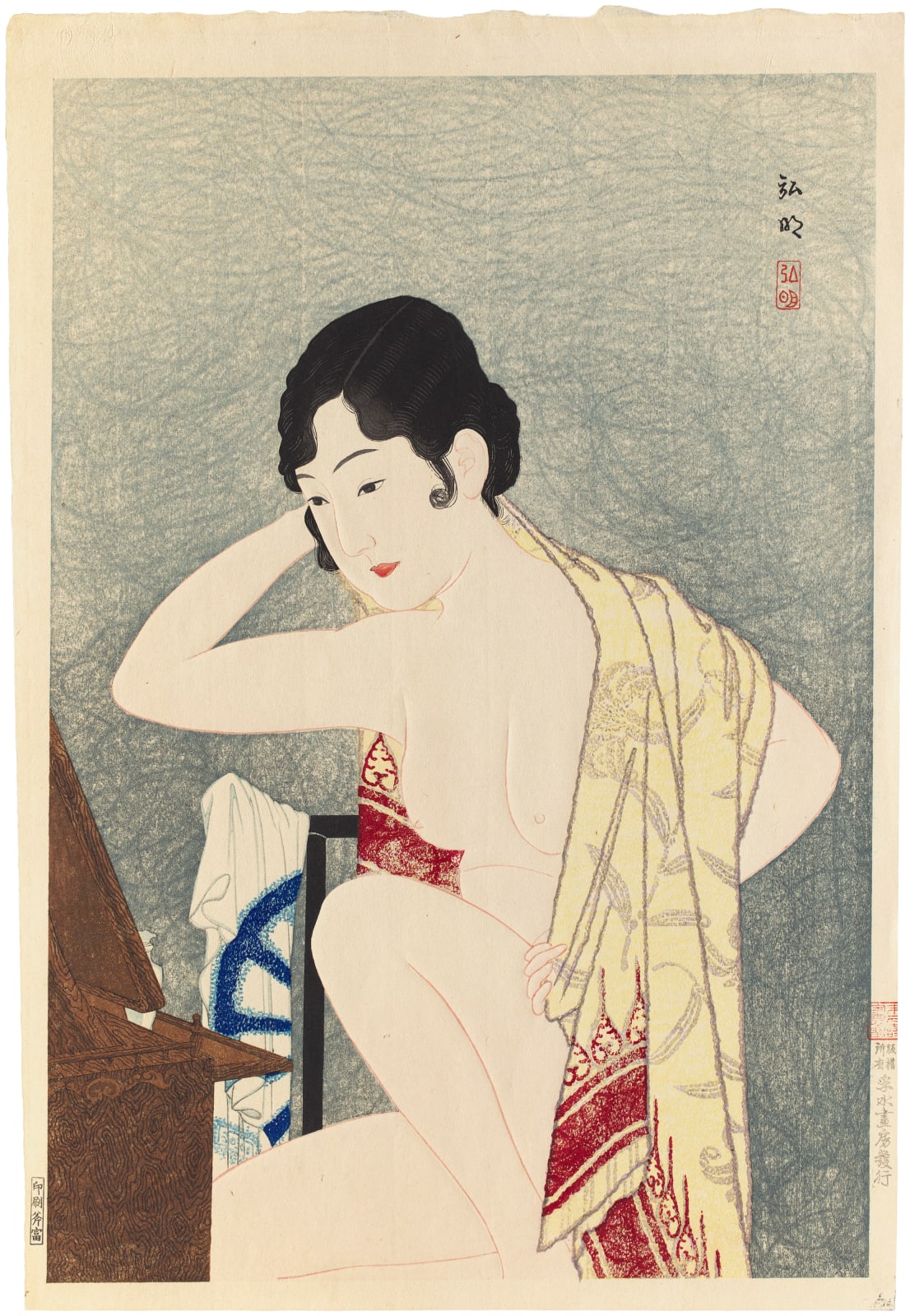Takahashi Shotei (Hiroaki) (1871-1945)
'Make-up - before the mirror' (Kagami no mae- Kesho), 1927
Woodblock print
Signed: 'Hiroaki'
Red artist's seal: 'Hiroaki'
Date: 1927
Publisher: Fusui Gabo (seal on lower right margin 'Hanken shoyu Fusui Gabo hakko')
Printer: Onotomi (seal to lower left margin 'Insetsu Onotomi')
Signed: 'Hiroaki'
Red artist's seal: 'Hiroaki'
Date: 1927
Publisher: Fusui Gabo (seal on lower right margin 'Hanken shoyu Fusui Gabo hakko')
Printer: Onotomi (seal to lower left margin 'Insetsu Onotomi')
Vertical dai-oban:
42.3 x 28.8 cm. (16 ⅝ x 11 ⅜ in.)
42.3 x 28.8 cm. (16 ⅝ x 11 ⅜ in.)
Very good impression, colour and overall condition with embossing to emphasise the outlines of the figure, slight toning, unidentified red collector's seal above publisher's mark in margin, the reverse with old label in English attached stating artist, print title and publisher details.
Sold
The word moga is an abbreviation of modan garu, which comes from the English 'modern girl'. Similar to the Western 'flapper' of the 1920s, moga were typically defined by their...
The word moga is an abbreviation of modan garu, which comes from the English 'modern girl'. Similar to the Western 'flapper' of the 1920s, moga were typically defined by their appearance - a bobbed haircut often with permed curls and the latest Western-style make-up. Instead of the traditional kimono, moga adopted shorter dresses and through earning an income outside of the home could adopt a more independent lifestyle, which would also involve going out dancing and drinking. Such behaviours lead to an image of moga as scandalous, flirtatious and promiscuous amongst many in society who still supported more traditional ideals.
Contemporary artists found moga a rich subject for their work and 20th century print designers such as Takahashi Shotei, Torii Kotondo (1900-1976), Kobayakawa Kiyoshi (1899-1948) and Ishikawa Toraji (1875-1964) readily incorporated them into their work.
In this print, 'Make-up - before the mirror' by Takahashi Shotei, depicts a nude young woman pulling a patterned towel across her shoulders to dry herself in front of a mirror. The setting is traditional and is based upon the genre of depicting female beauties (bijin-ga) - a popular subject of Japanese woodblock prints over the previous centuries, however the woman's haircut identifies her as a 1920s moga, following the latest hair trends.
Contemporary artists found moga a rich subject for their work and 20th century print designers such as Takahashi Shotei, Torii Kotondo (1900-1976), Kobayakawa Kiyoshi (1899-1948) and Ishikawa Toraji (1875-1964) readily incorporated them into their work.
In this print, 'Make-up - before the mirror' by Takahashi Shotei, depicts a nude young woman pulling a patterned towel across her shoulders to dry herself in front of a mirror. The setting is traditional and is based upon the genre of depicting female beauties (bijin-ga) - a popular subject of Japanese woodblock prints over the previous centuries, however the woman's haircut identifies her as a 1920s moga, following the latest hair trends.
3
of
3

